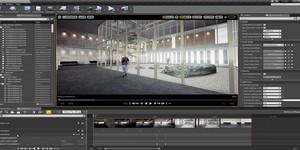
Epic Games has announced an update to its Unreal Engine 4 game engine, bringing a new shading renderer optimised for virtual reality, 'Contact Shadows' for more detailed shading, and support for the Vulkan application programming interface (API) on Android devices.
Bringing the Unreal Engine to version 4.14, the major new feature of Epic's update comes in the form of a forward shading renderer which the company claims is specifically optimised for virtual reality. Support for Unreal Engine's existing lighting features alongside multi-sample antialiasing (MSAA) or temporal antialiasing (TAA) provides the quality, while a frustrum-space grid allows lights and reflections outside the viewer's primary focus to be culled in order to improve performance. Stationary lights have dynamic shadows precomputed, allowing for multiple shadow effects without the usual performance loss.
Sadly, the current forward shading renderer does come with some limitations: various screen space techniques, such as screen space ambient occlusion (SSAO) and screen space reflection (SSR) are not supported, nor are movable lights able to cast shadows. MSAA is also only available on selected content, with D-buffer decals, motion blur, dynamic shadows, and capsule shadows not able to benefit from the feature. Despite this, developers may want to enable the functionality for VR titles: Epic's own Robo Recall game benefits from a 22 percent performance boost under the new renderer when running on an Nvidia GeForce GTX 970 graphics card.
Another feature new to Unreal Engine 4.14 but sadly deactivated when using the forward shading renderer is contact shadows, a new form of dynamic shadow rendered as a short ray-cast on complex objects. Using this, Epic claims, it's possible to get highly detailed shadow on complex objects at a very low performance cost. The engine is additionally now able to automatically generate different levels of detail (LOD) for in-game models using quadric mesh simplification, pre-compute different lighting scenarios for scenes with matched geometry, offers full-resolution skin shading, per-pixel translucent lighting, and supports Nvidia's Ansel in-game photography tool via a bundled plugin.
More information on the new release, including additional new features including improved cable model handling and font outlines, can be found from the official announcement.
Bringing the Unreal Engine to version 4.14, the major new feature of Epic's update comes in the form of a forward shading renderer which the company claims is specifically optimised for virtual reality. Support for Unreal Engine's existing lighting features alongside multi-sample antialiasing (MSAA) or temporal antialiasing (TAA) provides the quality, while a frustrum-space grid allows lights and reflections outside the viewer's primary focus to be culled in order to improve performance. Stationary lights have dynamic shadows precomputed, allowing for multiple shadow effects without the usual performance loss.
Sadly, the current forward shading renderer does come with some limitations: various screen space techniques, such as screen space ambient occlusion (SSAO) and screen space reflection (SSR) are not supported, nor are movable lights able to cast shadows. MSAA is also only available on selected content, with D-buffer decals, motion blur, dynamic shadows, and capsule shadows not able to benefit from the feature. Despite this, developers may want to enable the functionality for VR titles: Epic's own Robo Recall game benefits from a 22 percent performance boost under the new renderer when running on an Nvidia GeForce GTX 970 graphics card.
Another feature new to Unreal Engine 4.14 but sadly deactivated when using the forward shading renderer is contact shadows, a new form of dynamic shadow rendered as a short ray-cast on complex objects. Using this, Epic claims, it's possible to get highly detailed shadow on complex objects at a very low performance cost. The engine is additionally now able to automatically generate different levels of detail (LOD) for in-game models using quadric mesh simplification, pre-compute different lighting scenarios for scenes with matched geometry, offers full-resolution skin shading, per-pixel translucent lighting, and supports Nvidia's Ansel in-game photography tool via a bundled plugin.
More information on the new release, including additional new features including improved cable model handling and font outlines, can be found from the official announcement.

MSI MPG Velox 100R Chassis Review
October 14 2021 | 15:04









Want to comment? Please log in.